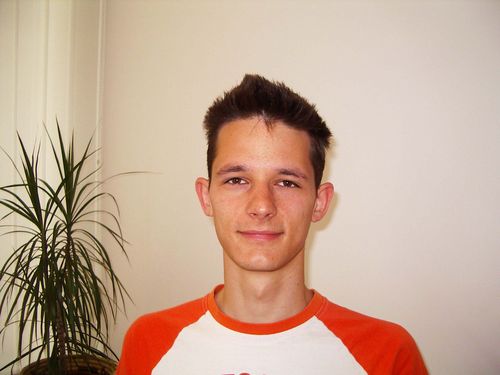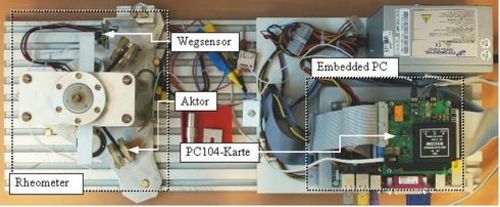
This diploma thesis deals with the further development of a rheometer prototype for the company Vialit Asphalt GmbH & Co. KG, opens an external URL in a new window, that would like to manufacture this rheometer as a low-cost device in a limited-lot production. In the first part of this thesis the function and the properties of the prototype are to be analysed and the assembly is to be characterised. Based on these results a displacement sensor, which fulfills low-cost requirements, was developed.
To control of the torque generating coils, a mathematical model of the actuator was created. This model was verified with a special construction to measure the force of the actuator. The mathematical model and the verification within the experiment has yielded the base upon which the redesign of the coils and development of the current generator was done. The current generator and the displacement signal conditioning circuit were implemented on a PC104-board. Using an embedded PC, a multi I/O DAQ card and the PC104-board a measurement system was set up, which can be controlled via a LAN connection (see Figure 1). The open source "Real Time Linux" operating system was chosen for the development. This system has been extended to work with a "Simulink Target for Real Time Linux" and a proc-filesystem driver. With this extension kernel modules capable to operate in real time can be generated out of a simulink model, which can be controlled via simulink and/or a web browser. The experiences from the installation and usage of the system are documented in an extensive appendix.
 Figure 1: A modified RTLinux System, which is capable of rapid prototyping with MATLAB/Simulink is running on the embedded PC (right). To control the rheometer (left) Simulink models were created, which can be controlled through a webbrowser.
Figure 1: A modified RTLinux System, which is capable of rapid prototyping with MATLAB/Simulink is running on the embedded PC (right). To control the rheometer (left) Simulink models were created, which can be controlled through a webbrowser.
 Figure 2: The interpretation under consideration of the dynamic rheometer model yields two graphs (dot dashed lines), which can be compared with a reference measurement (solid line).
Figure 2: The interpretation under consideration of the dynamic rheometer model yields two graphs (dot dashed lines), which can be compared with a reference measurement (solid line).
By request of Vialit first rheological measurements were also carried out using lab devices. For this setup a LabView program was developed, where the temperature can be regulated with devices capable of GPIB functionality. Furthermore the regulation of the magnet displacement is done via a PI-controller which fulfills soft real time requirements. The measuring results (see Figure 2) show that the evaluation of the rheological values must be done in consideration of the dynamic model of the entire system. In a system analysis all important properties and functions of the rheometer are exactly examined. A large part of the identified problems could be solved already within this thesis.
The circulation of the project work is restricted from March 16, 2007 for a period of 5 years.
March 2007